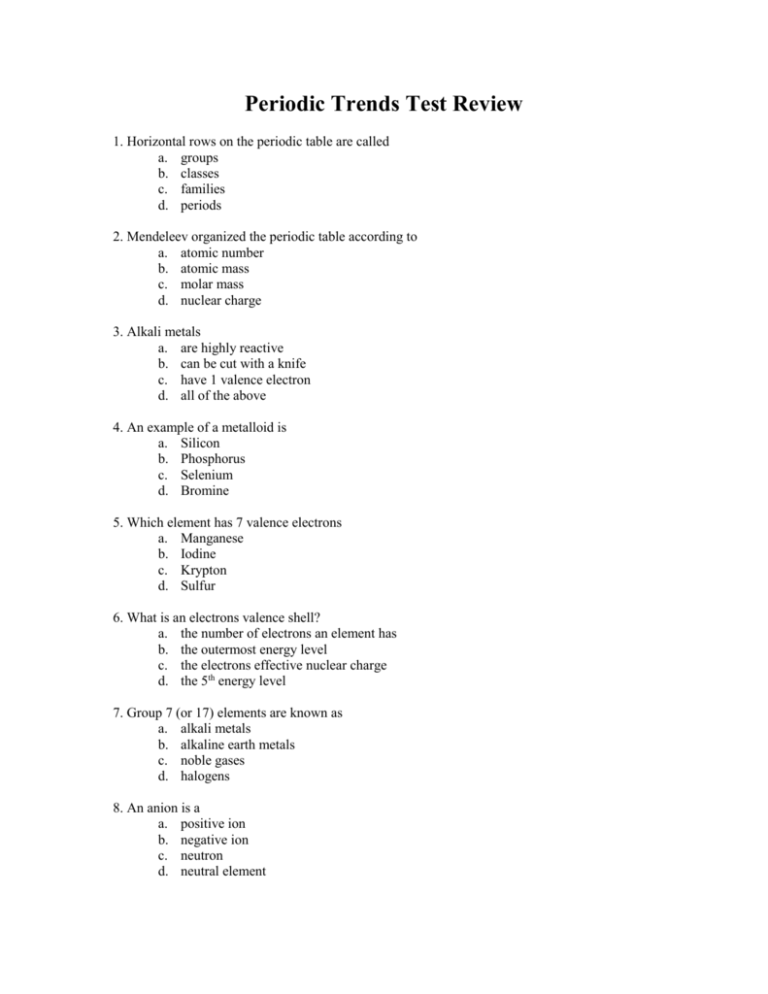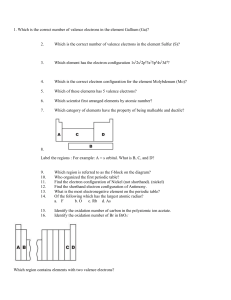Document
advertisement

Periodic Trends Test Review 1. Horizontal rows on the periodic table are called a. groups b. classes c. families d. periods 2. Mendeleev organized the periodic table according to a. atomic number b. atomic mass c. molar mass d. nuclear charge 3. Alkali metals a. are highly reactive b. can be cut with a knife c. have 1 valence electron d. all of the above 4. An example of a metalloid is a. Silicon b. Phosphorus c. Selenium d. Bromine 5. Which element has 7 valence electrons a. Manganese b. Iodine c. Krypton d. Sulfur 6. What is an electrons valence shell? a. the number of electrons an element has b. the outermost energy level c. the electrons effective nuclear charge d. the 5th energy level 7. Group 7 (or 17) elements are known as a. alkali metals b. alkaline earth metals c. noble gases d. halogens 8. An anion is a a. positive ion b. negative ion c. neutron d. neutral element 9. Argon is an example of a. noble gas b. halogen c. metalloid d. metal 10. How many valence electrons does Aluminum have? a. 5 b. 13 c. 3 d. 4 11. Where are non-metals found on the periodic table? a. left b. right c. between metals and metalloids d. scattered throughout the periodic table 12. Columns on the periodic table are known as a. periods b. classes c. sections d. groups 13. To which class do Ca and Ba belong? a. alkali metals b. halogens c. alkaline earth metals d. noble gases 14. Which of the following is NOT a characteristic of a metal? a. malleable b. ductile c. semi-conductor d. mostly solid at room temperature 15. Periodic law states a. physical properties of elements are functions of their atomic number b. chemical properties of elements are functions of their atomic number c. both a and b d. none of the above 16. Which element has the smallest atomic radius? a. Cesium (Cs) b. Hafnium (Hf) c. Gold (Au) d. Mercury (Hg) 17. Which element has the highest electron affinity? a. Carbon b. Fluorine c. Oxygen d. Lithium 18. How many energy levels does Ca have? a. 1 b. 2 c. 3 d. 4 19. An element that gains an electron becomes a. a cation b. an anion c. an isotope d. neutron 20. Which of the following elements would most likely because a cation? a. Potassium b. Aluminum c. Chlorine d. Fluorine 21.An ion is an element that has a. gained an electron b. lost an electron c. a neutral charge d. gained or lost an electron 22. As ENC increases a. electron affinity increases b. electronegativity increases c. ionization energy increase d. all of the above 23. Effective nuclear charge is approximately equal to a. the number of electrons an element has b. the number of valence electrons an element has c. the number of energy levels an element has d. the ionization energy 24. Atomic Radius is highest on the periodic table a. the bottom left b. the bottom right c. the top left d. the top right 25. Which of the following elements has the highest ionization energy a. Lithium b. Potassium c. Neon d. Fluorine 26. Which of the following elements is the least electronegative a. Carbon b. Nitrogen c. Bromine d. Sulfur 27. A cation is always a. larger b. smaller c. equal to in size d. double than the element from which it was formed 28. An electron that is available to be lost, gained or shared is called a. ground state electron b. valence electron c. valence shell d. electronegative 29. Which element would be most like Iron in physical and chemical properties a. Ruthenium b. Nickel c. Calcium d. Iridium 30. Which of the following elements has the largest atomic radius a. Magnesium b. Chlorine c. Rubidium d. Phosphorus 31. How many valence electrons does He have? a. 8 b. 2 c. 1 d. 4 32. Whose work led to the recognition that atomic number not atomic mass is the basis for the organization of the periodic table? a. Mendeleev b. Rutherford c. Bohr d. Moseley 33. Electronegativity is a. the ability of an atom to give away electrons b. the ability of an atom to gain electrons c. the ability of an atom to remain neutral d. the ability of an atom to become and ion 34. Which isotope of Carbon would be most common? a. C-14 b. C-12 c. C-11 d. C-6 35. What is the molar mass of I2? a. 126.90 g b. 126.90 amu c. 253.80 g d. 253.80 amu 36. What is the most common isotope of Boron? 37. List 2 differences between metals, non-metals and metalloids 38. Ag has 2 isotopes, Ag-107 (106.91 amu) and Ag-109 (108.90). What is the percent abundance of each of the two isotopes? 39. Explain why the ionization energy of Magnesium is higher than that of Lithium. 40. How many moles are there in 3.00g of boron tribromide, BBr3? Answer Sheet 1.d 39. Because Magnesium has a higher ENC 2.b so it holds the electrons tighter. If the electrons are 3.d tighter, it takes more energy to remove one 4.a 40. 3g BBr3 x (1 mol/ 250.51g BBr3) 5.b = 0.012 mol BBr3 6.b 7.d 8.b 9.a 10.c 11.a 12.d 13.c 14.c 15.c 16.d 17.b 18.d 19.b 20.a 21.d 22.d 23.b 24.a 25.d 26.a 27.b 29.a 30.c 31.b 32.d 33.b 34.b 35.d 36.B-5 37. Metals-malleable, ductile, high tensile strength, good conductor Metalloid- medium level of malleability, ductile and tensile strength, semiconductor Non-metal-not malleable nor ductile, low tensile strength, poor conductor 38. x(106.91) + (1-x)(108.90) = 107.87 106.91x + 108.90 - 108.90x = 107.87 -1.99x + 108.90 = 107.87 -1.99x = -1.03 x= .52 and 1-x = .48 Ag-107 is 52 % and Ag-109 is 48%






